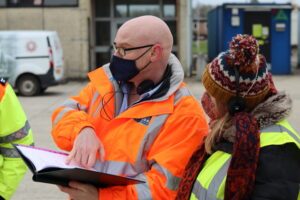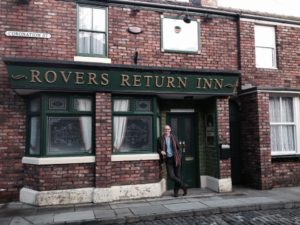Culture And Behaviours
‘Good stories can embody your ethics and way of working,’ SHP meets Tribe’s David Mansell
David Mansell, Creative Consultant at Tribe Culture Change, talks to SHP about his career in television, why he believes storytelling and safety go hand in hand and looks forward to Tribe’s drama presentation, which he wrote and is the first of its kind, taking place at Safety & Health Expo in May.
 David’s background is in television scriptwriting and production, previous roles have included behind the scenes work, editing scripts, producing and directing on shows like Casualty, EastEnders and Coronation Street. David now uses his skills and experience to encourage businesses embrace the power of story to influence a positive shift in culture.
David’s background is in television scriptwriting and production, previous roles have included behind the scenes work, editing scripts, producing and directing on shows like Casualty, EastEnders and Coronation Street. David now uses his skills and experience to encourage businesses embrace the power of story to influence a positive shift in culture.
Engage people at work: From Coronation Street to culture change
Can you start by giving our readers a bit of an insight into your career so far, what influenced that shift in your career from TV to culture change?
David Mansell (DM): “I originally started my career working in theatre management before moving into a more creative role in television – and I worked on shows like ‘Casualty’, ‘EastEnders’, ‘Doctor Who’, ‘Red Rock’, ‘Holby City’ and ‘Coronation Street’. I straddled a number of roles on these shows from script editor to Producer and, finally, Director.

“Throughout that time, I spent a large percentage of my time with writers, learning about how stories work. I made the leap across into culture change in 2019 because I saw Tribe truly making an impact on peoples’ lives, health and wellbeing in the organisations they worked with… and maybe even saving some lives on the way.
“That was what drew me in to working in this area – it was the knowledge that the work that we do ‘means something’. I’ve recently made a suicide prevention film for one of our clients… illustrating how we can all learn how to spot the signs that someone might be having suicidal thoughts, to have open conversations and to help an individual at risk to stay safe.
“If that film saves just one life, then it was worth every moment of the effort making it.”
Can you summarise Tribe’s main ethos, what do you hope to achieve through your performances?
(DM): “We work with companies to support them on their culture change journey, and to drive the momentum to sustain it for the long term. It’s effectively about identifying their ‘journey of change’… or, put another way, working out what their story is. There isn’t a magic wand that can be waved over a business to suddenly solve all of its problems overnight, but the use of story is a tool that can (when used correctly) be effective in tackling its issues.
“Tribe’s approach begins when we carry out a culture assessment, and the findings of that assessment determines the approach to create a tailored programme for a culture change programme in an organisation. Part of that programme may include the use of stories in workshops – and that might be a film, or a live drama performance, or an interactive exercise that has story –telling elements firmly embedded into it. This is because we know that a great story will engage the emotional part of a person’s brain – not just the retinal. And so, the message stays with you… because it makes you feel something. We help our clients to look for positive examples of behaviours and good news safety stories… and help them to retell those stories in a memorable way, to find the moral of the story and to inspire others to repeat the excellence.
“Essentially, health, safety and wellbeing doesn’t have to be dry. With unique insight and creative engagement, we help organisations to go on a journey to a happier, healthier and safer workplace culture. At Safety & Health Expo, this performance will showcase one of the many tools in our toolbox to support organisations in reaching this goal. It won’t just be a passive performance, there will be audience involvement – but not like a panto where you get hauled up on stage!”
Your drama piece at Safety & Health Expo will be about tackling health and wellbeing at work, what research did you conduct into the issue before writing the piece, did you draw on personal experience/that of others involved in the creative process?
 (DM): “Mental health and wellbeing is becoming an increasingly important part of the work we are doing with our clients, and rightly so. Certainly, since the pandemic, mental health has been thrust into the spotlight, with companies taking a long, hard look at what they can do to help their people cope with whatever life has thrown at us over the last two years.
(DM): “Mental health and wellbeing is becoming an increasingly important part of the work we are doing with our clients, and rightly so. Certainly, since the pandemic, mental health has been thrust into the spotlight, with companies taking a long, hard look at what they can do to help their people cope with whatever life has thrown at us over the last two years.
“During the pandemic, we spoke to many leaders to uncover the health, safety and wellbeing challenges they were facing. These insights formed the basis of a series of reports we published on how leaders should respond to the unprecedented times we found ourselves in.
“Not unsurprisingly, the negative impact on workforces’ mental health and wellbeing was one of the most pressing issues.
“Increasingly we’re working with clients on how to support their people with mental health and wellbeing. From making films about suicide prevention to dramas about burn out and stress, our work in this area is becoming more and more important to me.”
When did you first realise that storytelling could be an effective method in engaging people at work? What experience triggered that realisation?
 (DM): “Archetypal story structure (as commonly used in films, literature, songs) is based on a character’s emotional journey (i.e. a character can do something at the end of a story that they can’t do at the beginning), they are causal (something happens because of something else) and the main character ‘wants’ something (to kill the giant shark, to escape from Dunkirk, to catch the serial killer). This mirrors many of the patterns that we experience in life… and why it resonates with us when used in the workplace.
(DM): “Archetypal story structure (as commonly used in films, literature, songs) is based on a character’s emotional journey (i.e. a character can do something at the end of a story that they can’t do at the beginning), they are causal (something happens because of something else) and the main character ‘wants’ something (to kill the giant shark, to escape from Dunkirk, to catch the serial killer). This mirrors many of the patterns that we experience in life… and why it resonates with us when used in the workplace.
“Stories can create “sticky” memories by attaching emotions to things that we witness or experience. We’re scared of the Big Bad Wolf menacing Little Red Riding Hood. We’re amused by the antics of Basil Fawlty. We’re saddened by ‘Titanic’. We’re thrilled by James Bond as he tracks down a super-villain. We remember them precisely because they inspire strong emotional reactions. If we’re truly swept away by a story, this makes us more likely to embrace the ideals and messages that it is promoting.
“We also remember stories because of a ‘journey of change’. We love to hear stories about someone who is bullied triumphing over their bully… or someone who is down on their luck winning the lottery… or, a husband or wife breaking free of their unfaithful partner. These are all tales of transformation. I talked about a character being able to do something at the end of a story that they cannot do at the beginning… and this is another reason why we engage with stories far more than we do with a list of statistics and facts. We feel an emotional engagement with a character who achieves something that they previously thought they might not be able to. As a viewer, we ‘root for’ Police Chief Brody as he strives to find the giant shark that is terrorising his home town in ‘Jaws’. He overcomes his self-doubt and fear of water to defeat the creature… and he saves the day. He has embarked on a journey of change, and we join him on that journey. We have engaged. It might be twenty or so years since you have seen ‘Jaws’ but I bet you can still tell me the story with a degree of accuracy, and tell me how you felt whilst watching it!
“Good stories stick with us longer – it’s as simple as that. This means leaders who can create and share good stories have a powerful advantage over others. We all know that effective communication is one of the most vital tools in any company’s kitbag. Good stories can embody your ethics and way of working… they can encourage customers to buy your products or inspire your teams to overcome a challenge. We tell stories to our co-workers and peers all the time — to persuade someone to support our project, to explain to an employee how he might improve, or to inspire a team that is facing challenges. If you have a message to get across, it is more likely to be remembered if it engages those who you tell it to on an emotional level.”
Why should attendees be sure to catch Tribe’s performance at Safety & Health Expo? What will be the main takeaway?
(DM): “My understanding is that there’s never been anything like this before at Safety & Health Expo, it’s new, it’s different… and it’s an opportunity not to be ‘talked at’. At Tribe we love stuff that’s a bit different, and that engages people mainly because we know that in some health and safety circles people just get talked at in a room… or suffer from ‘death by PowerPoint’. We want to make an impact on people by surprising them, by subverting expectations, engaging them on an emotional level and making the work we do memorable. In essence, the work becomes ‘sticky’… because it stays with people.
“And people’s mental health and wellbeing is so important. We should all be taking the time to listen to our colleagues (but making sure that we really listen). It’s everyone’s responsibility to make sure people thrive.”
What are you most looking forward to about the return to face-to-face events and being back in front of an audience again?
(DM): “I’m very much looking forward to seeing people face-to face and connecting with lots of clients and potential clients. There will be lots of interesting stuff going on our stand (SH2678), for instance we’ll be playing giant Jenga every day; there’ll be demos of our culture change membership platform – Chrysalis Culture Hub; lots more examples of how we create sticky learning experiences and sharing with people how these sticky moments fit into the wider strategic approach to culture change.
‘Good stories can embody your ethics and way of working,’ SHP meets Tribe’s David Mansell
David Mansell, Creative Consultant at Tribe Culture Change, talks to SHP about his career in television and why he believes storytelling and safety go hand in hand.
Chrissie Joslin
SHP - Health and Safety News, Legislation, PPE, CPD and Resources Related Topics
British Safety Council Wellbeing Conference: Empowering Employees for Success
New flexible working legislation – what does it mean?
Lives depend on asbestos action, says IOSH

 David’s background is in television scriptwriting and production, previous roles have included behind the scenes work, editing scripts, producing and directing on shows like Casualty, EastEnders and Coronation Street. David now uses his skills and experience to encourage businesses embrace the power of story to influence a positive shift in culture.
David’s background is in television scriptwriting and production, previous roles have included behind the scenes work, editing scripts, producing and directing on shows like Casualty, EastEnders and Coronation Street. David now uses his skills and experience to encourage businesses embrace the power of story to influence a positive shift in culture.
 (DM): “Mental health and wellbeing is becoming an increasingly important part of the work we are doing with our clients, and rightly so. Certainly, since the pandemic, mental health has been thrust into the spotlight, with companies taking a long, hard look at what they can do to help their people cope with whatever life has thrown at us over the last two years.
(DM): “Mental health and wellbeing is becoming an increasingly important part of the work we are doing with our clients, and rightly so. Certainly, since the pandemic, mental health has been thrust into the spotlight, with companies taking a long, hard look at what they can do to help their people cope with whatever life has thrown at us over the last two years. (DM): “Archetypal story structure (as commonly used in films, literature, songs) is based on a character’s emotional journey (i.e. a character can do something at the end of a story that they can’t do at the beginning), they are causal (something happens because of something else) and the main character ‘wants’ something (to kill the giant shark, to escape from Dunkirk, to catch the serial killer). This mirrors many of the patterns that we experience in life… and why it resonates with us when used in the workplace.
(DM): “Archetypal story structure (as commonly used in films, literature, songs) is based on a character’s emotional journey (i.e. a character can do something at the end of a story that they can’t do at the beginning), they are causal (something happens because of something else) and the main character ‘wants’ something (to kill the giant shark, to escape from Dunkirk, to catch the serial killer). This mirrors many of the patterns that we experience in life… and why it resonates with us when used in the workplace.